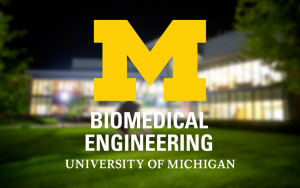Presented By: Biomedical Engineering
PhD Defense: Richard Youngblood
Bioengineered Scaffold Microenvironment Promotes Assembly and Differentiation of Stem Cell-Derived Human Organoids

NOTICE: This event will be held via Blue Jeans. The link will be posted below.
BlueJeans: https://bluejeans.com/855683101
Human pluripotent stem cells (hPSCs) differentiated into complex three-dimensional (3D) structures, referred to as ‘organoids’ due to their organ-like properties, offer ideal platforms to study human development, disease and regeneration. However, studying organ morphogenesis has been hindered by the lack of appropriate culture systems that can spatially enable cellular interactions that are needed for organ formation. Many organoid cultures rely on decellularized extracellular matrices as supportive scaffolds, which are often poorly chemically defined and allow only limited tunability and reproducibility. By contrast, engineered synthetic matrices can be tuned and optimized to mimic the embryo environment in order to enhance development and maturation of organoid cultures. Herein, this work primarily focuses on using synthetic polymer matrices to investigate how the design of biomaterials can guide key interactions guiding stem-cell decisions for the reproducible generation and control of organoid cultures.
Microporous biomaterials comprised of synthetic polymer materials were shown to guide the assembly of pancreatic progenitors into insulin-producing clusters that further developed into islet organoids. The scaffold culture facilitated cell-cell interactions enabled by the scaffold design and supported cell-mediated matrix deposition of extracellular matrix (ECM) proteins associated with the basement membrane of islet cells. Furthermore, when compared to suspension cultures, the scaffold culture showed increased insulin secretion in response to glucose stimulus indicating the development of functional β-cells. By modifying the stage that cells were seeded on scaffolds from pancreatic progenitor to pancreatic endoderm, islet organoids showed increased amounts of insulin secreted per cell. In addition, seeding scaffolds with dense clusters instead of a single suspension minimized cell manipulation during the differentiation, which was shown to be influential to the development of the islet organoids. An engineered insulin reporter further identified how mechanistic changes in vitro influenced function within individual cells by measuring insulin storage and secretion through non-invasive imaging.
hPSC-derived lung organoids (HLOs) were also evaluated for in vivo maturation on biomaterial scaffolds, where HLOs were shown improved tissue structure and cellular differentiation. Investigative studies demonstrated that scaffold pore interconnectivity and polymer degradation contributed to in vivo maturation, the size of the airway structures and the total size of the transplanted tissue. Polymer biomaterials were also developed to modulate local tissue and systemic inflammation through local delivery of human interleukin 4 (hIL-4)-expressing lentivirus. Microporous scaffold culture strategies improve organoid complexity and exert fine control over the system using engineering solutions, thus, allowing the community to build more realistic organoid tools. Taken together, the microporous scaffold culture demonstrates the feasibility to translate organoid culture to the clinic as a biomanufacturing platform.
Chair: Dr. Lonnie Shea
BlueJeans: https://bluejeans.com/855683101
Human pluripotent stem cells (hPSCs) differentiated into complex three-dimensional (3D) structures, referred to as ‘organoids’ due to their organ-like properties, offer ideal platforms to study human development, disease and regeneration. However, studying organ morphogenesis has been hindered by the lack of appropriate culture systems that can spatially enable cellular interactions that are needed for organ formation. Many organoid cultures rely on decellularized extracellular matrices as supportive scaffolds, which are often poorly chemically defined and allow only limited tunability and reproducibility. By contrast, engineered synthetic matrices can be tuned and optimized to mimic the embryo environment in order to enhance development and maturation of organoid cultures. Herein, this work primarily focuses on using synthetic polymer matrices to investigate how the design of biomaterials can guide key interactions guiding stem-cell decisions for the reproducible generation and control of organoid cultures.
Microporous biomaterials comprised of synthetic polymer materials were shown to guide the assembly of pancreatic progenitors into insulin-producing clusters that further developed into islet organoids. The scaffold culture facilitated cell-cell interactions enabled by the scaffold design and supported cell-mediated matrix deposition of extracellular matrix (ECM) proteins associated with the basement membrane of islet cells. Furthermore, when compared to suspension cultures, the scaffold culture showed increased insulin secretion in response to glucose stimulus indicating the development of functional β-cells. By modifying the stage that cells were seeded on scaffolds from pancreatic progenitor to pancreatic endoderm, islet organoids showed increased amounts of insulin secreted per cell. In addition, seeding scaffolds with dense clusters instead of a single suspension minimized cell manipulation during the differentiation, which was shown to be influential to the development of the islet organoids. An engineered insulin reporter further identified how mechanistic changes in vitro influenced function within individual cells by measuring insulin storage and secretion through non-invasive imaging.
hPSC-derived lung organoids (HLOs) were also evaluated for in vivo maturation on biomaterial scaffolds, where HLOs were shown improved tissue structure and cellular differentiation. Investigative studies demonstrated that scaffold pore interconnectivity and polymer degradation contributed to in vivo maturation, the size of the airway structures and the total size of the transplanted tissue. Polymer biomaterials were also developed to modulate local tissue and systemic inflammation through local delivery of human interleukin 4 (hIL-4)-expressing lentivirus. Microporous scaffold culture strategies improve organoid complexity and exert fine control over the system using engineering solutions, thus, allowing the community to build more realistic organoid tools. Taken together, the microporous scaffold culture demonstrates the feasibility to translate organoid culture to the clinic as a biomanufacturing platform.
Chair: Dr. Lonnie Shea